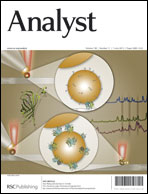Integration of microsphere resonators with bioassay fluidics for whispering gallery mode imaging
Abstract
Whispering gallery mode resonators are small, radially symmetric dielectrics that trap light through continuous total internal reflection. The resonant condition at which light is efficiently confined within the structure is linked with refractive index, which has led to the development of sensitive label-free sensing schemes based on whispering gallery mode resonators. One resonator design uses inexpensive high index glass microspheres that offer intrinsically superior optical characteristics, but have proven difficult to multiplex and integrate with the fluidics for sample delivery and fluid exchange necessary for assay development. Recently, we introduced a fluorescence imaging approach that enables large scale multiplexing with microsphere resonators, thus removing one obstacle for assay development. Here we report an approach for microsphere immobilization that overcomes limitations arising from their integration with fluidic delivery. The approach is an adaptation of a calcium-assisted glass bonding method originally developed for microfluidic glass chip fabrication. Microspheres bonded to glass using this technique are shown to be stable with respect to fluid flow and show no detectable loss in optical performance. Measured Q-factors, for example, remain unchanged following sphere bonding to the substrate. The stability of the immobilized resonators is further demonstrated by transferring


 Please wait while we load your content...
Please wait while we load your content...